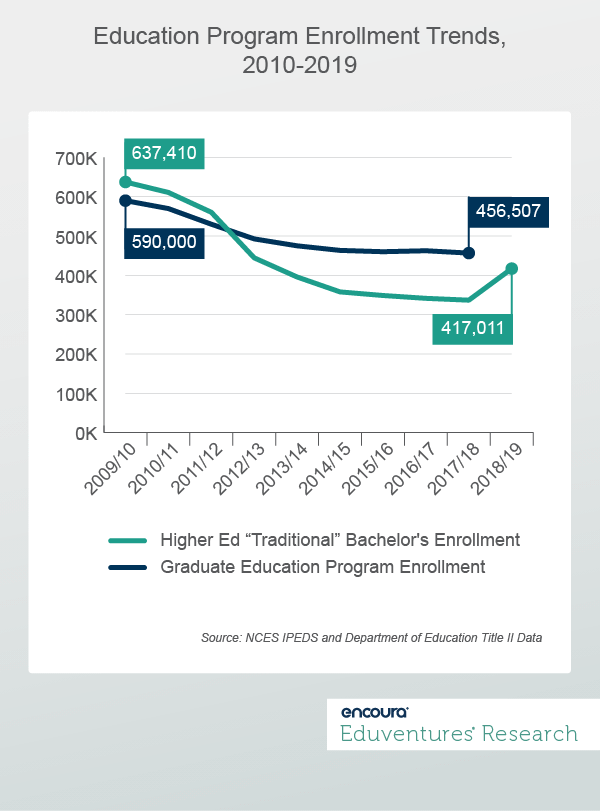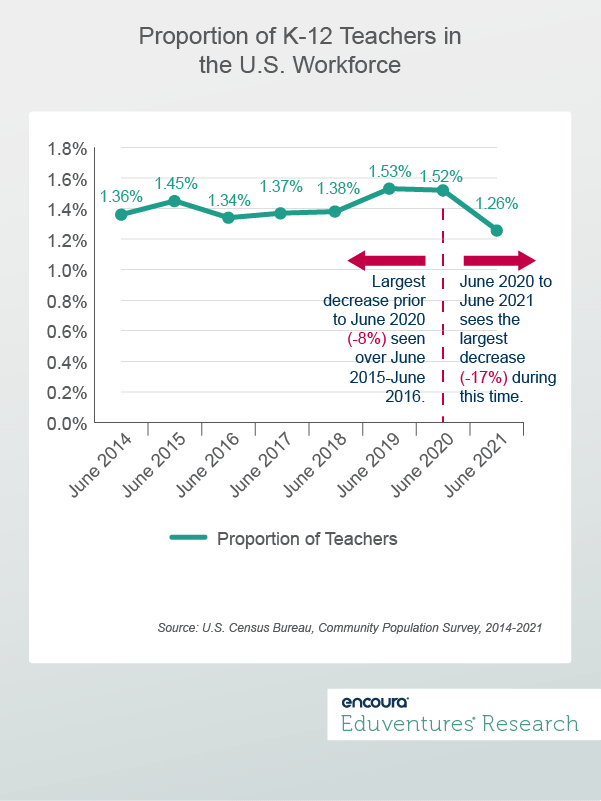With September in full swing, K-12 teachers have returned to the classroom. And after enduring a year of hastily designed remote learning or careful mitigation of in-person instruction, they were no doubt eager for a sense of normalcy. The only certainty ahead, however, is that this year is shaping up to be anything but certain.
Pre-pandemic trends surrounding the teaching profession, including years of reduced pipeline and prognostications on an impending retirement crunch, were anything but rosy. Add a global health crisis and these problems are certain to be compounded with major implications for teacher preparation and other education degree programs.
Pre-Pandemic Trends
The national teacher shortage, which is less an absolute shortage and more acute within specific subjects (e.g., special education and STEM) and certain schools (e.g., those serving lower socioeconomic populations) can largely be attributed to two key factors: poor teacher retention and declining interest among future teacher prospects.
And who can blame them? Ever increasing job responsibilities, a lack of professional advancement pathways, poor professional development opportunities—all these issues have been identified as leading causes for teacher retention and pipeline issues. Add the fact these issues have played out during a period that saw K-12 teacher base pay fall by nearly 2% and it is easy to see why the profession has lost some of its shine.
Enrollment data, as Figure 1 details, helps illustrate declining interest in education programs at the undergraduate and graduate levels.

Between 2010 and 2019, enrollment in traditional bachelor’s teacher preparation programs fell by 35%. The recent uptick observed in 2018-2019 provides hope that this market holds signs of rebounding, but it is too soon to say if that is a developing trend. In fact, Eduventures proprietary data suggests otherwise.
Eduventures’ 2020 Survey of Admitted Students™, fielded to high school seniors in the spring of 2020 amid the pandemic’s first wave revealed that interest in majoring in education fell by 10% from 2019 to 2020. Watching teachers struggle through pandemic-related challenges in real time may have thrown a wrench in the already precarious teacher pipeline as declining interest, at least temporarily, appears to have hastened.
At the prospect stage, too, Eduventures has tracked a downward trend in education major interest. Our 2019, 2020, and 2021 Prospective Student Survey™, fielded to college-bound high school sophomores, juniors, and seniors who intend to enroll in postsecondary education upon graduation, revealed a gradual decline in education major interest from 5% of prospects in 2019, to 4% in 2020, to 3% in 2021.
As Figure 1 demonstrates, education programs at the graduate level have also been challenged in recent years as enrollments declined by 23% between 2010 and 2018. More recently, insights from Eduventures Adult Prospect Research suggests more challenging times ahead. Of those adult prospects indicating interest in a master’s degree, those also selecting education as their field of study preferences shrank from 11.1% percent in July 2019, to 9.9% percent in June 2020, to 8.4% percent in October 2020, a 24.5% decline over that period.
Under Pressure
Adding to this picture, efforts to gauge the attitudes of the K-12 teaching force during COVID-19 reveal high levels of burn out, stress, and fatigue. A survey conducted by The Center for State and Local Government Excellence found that K-12 employees reported feeling stressed (63%), burned out/fatigued (54%), and/or anxious (47%) at work due to the pandemic—all of which are higher rates compared to other government employees.
Another survey conducted by The RAND Corporation found that while 40% of all employed adults reported experiencing frequent job-related stress during the pandemic, this figure jumped to 78% for K-12 teachers. More alarmingly, both surveys pointed to higher rates of job change consideration among this group. The RAND study found that “nearly one in four teachers said that they were likely to leave their jobs by the end of the 2020–2021 school year, compared with one in six teachers who were likely to leave, on average, prior to the pandemic.”
Additionally, the PEW Charitable Trust previously reported that nearly all states suffered declines in education jobs from September 2019 to September 2020 as a result of COVID-19-related budget pressures, hiring freezes, and temporary layoffs. Local news stations continue to feature stories about signing bonuses for bus drivers and other school infrastructure staff. But is there evidence of a pandemic-influenced exodus from the K-12 teaching profession? Unfortunately, Department of Education data detailing these trends is not yet available, but the U.S. Census Bureau’s Current Population Survey (CPS) provides a good starting point.
Figure 2 details the proportion of K-12 teachers in the U.S. workforce based on responses to the CPS every June dating back to 2014.

Figure 2 shows that prior to 2020, the largest decline in the proportion of K-12 teachers in the U.S. workforce was seen from June 2015 to June 2016 (-8%). From June 2020 to June 2021, however, during COVID-19’s first wave, there was a 17% decline representing the largest change since 2014. The CPS does not provide more details on why this shift may have occurred, but we can assume that this dip reflects multiple factors: COVID-19-influenced reductions in force increased teacher frustration leading to job change or a temporary break and potential pipeline issues affecting new teacher counts. To what degree these factors played a role in this dip is a question worth continued attention as more data is made available.
The Bottom Line
The pressures on the K-12 teaching profession have major implications for providers of teacher preparation and other education degree programs, and early signs suggest existing market challenges have been further complicated by the pandemic. Many hold out hope for a robust policy response addressing the teacher pipeline and teacher retention to counter these forces.
In the shorter-term, however, Schools of Education must understand that recent events may be exacerbating the already known challenge of waning interest in education programs. But what can schools do? All schools must ensure they have a compelling blend of programming that meets high need teacher areas and prepares graduates with the right skills in a volatile professional setting.
Although not detailed in this post, bachelor’s and master’s degree conferral trends show widescale decline across education-focused program markets over the last decade. This data, however, does reveal some rays of light in an otherwise cloudy outlook. More granular analysis of conferral data reveals three clear programmatic bright spots: special education, leadership, and technology.
Will these markets continue to outshine the rest of the education program market? It makes sense that they could. Special education—ubiquitous in job posting data, state needs assessments, and inclusion in eligibility for TEACH grants—remains a high-need teaching field. We are also at a point when strong school leadership is needed now more than ever to guide teachers, children, and their parents through the challenges ahead. Finally, after a year that saw unprecedented use of technology at the K-12 level, often hastily so, a period of refinement may lie ahead to evolve and define the ideal blend of teaching and learning technologies to complement the in-person classroom experience.
Never Miss Your Wake-Up Call
Learn more about our team of expert research analysts here.
Eduventures Senior Analyst at Encoura
Contact
The Program Strength Assessment (PSA) is a data-driven way for higher education leaders to objectively evaluate their programs against internal and external benchmarks. By leveraging the unparalleled data sets and deep expertise of Eduventures, we’re able to objectively identify where your program strengths intersect with traditional, adult, and graduate students’ values, so you can create a productive and distinctive program portfolio.
Thursday September 30, 2021 at 2PM ET/1PM CT
Every enrollment office is now quick to jump on digital recruiting efforts to keep up with Gen Z. However, the marketing options can seem endless. Given limited time and resources, how should enrollment and marketing leaders decide which digital solutions would prove to be the best investment and most appealing to incoming classes?
In this webinar, VP of Encoura Digital Solutions Reva Levin will reveal the secret sauce to digital outreach for any undergraduate enrollment team. Join us on Thursday, September 30 as she shares the three key ingredients that will give your digital recruitment strategies a flavor that your prospective students will love!

